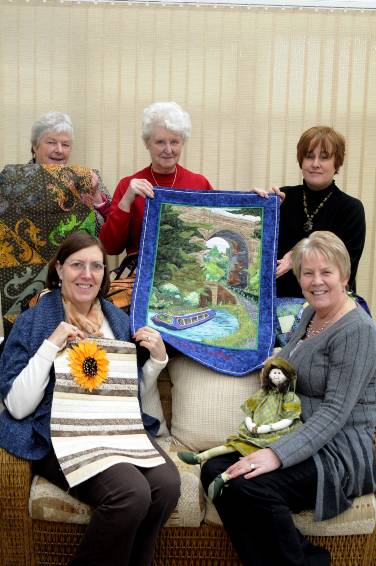Ancient art of quilting given a modern feel
Reporter: Janice Barker
Date published: 23 February 2010

WE did this . . . (back, from left) Pat Bridgestock, Shirley Thornley and Carmen Walton and (seated) Susan Rodgers and Sue Warburton
Quilts were made in stately homes, humble cottages, Amish communities in America and convicts on their way to Australia. From prosaic coverlets made out of necessity from scraps of old clothing, to sumptuous embroidered covers detailing the lives of royalty, the quilt has a unique place in history.
As a major new exhibition opens at the Victoria and Albert Museum in London, reporter Janice Barker found out more about local women who keep the tradition going.
A major display at the Victoria & Albert Museum will unite the modern world of artists Grayson Perry and Tracy Emin with a sumptuous silk and velvet bedcover linked to Charles II’s visit to an Exeter manor house in the late 17th century.
The V&A will present its first ever exhibition of British quilts on March 20, with examples dating from 1700 to the present day.
There are 65 beautifully crafted quilts, predominantly from the museum’s own collection but also including a number of important loans and new works by contemporary artists, many of which have been commissioned especially for the show.
And one local women keen to see the crafts on show is Carmen Walton, of the Canalside Quilters who meet at the Saddleworth Museum.
A self-taught quilter, Carmen said: “I’ve been asking why there hasn’t been an exhibition like this for 30 years.
“One of the things which has happened is that quilts were not considered important so very few have survived.
“Quilting does suffer from an image problem — it is a bit utility, or a bit ‘granny’.
“But now you have people like Tracy Emin doing quilting.”
Carmen joins fellow quilters, led by local expert Sue Warburton, at the museum in Uppermill every month.
They take their name from their idyllic location, in a room overlooking the canal and its leafy banks.
Despite being a group, each member has their own distinct style of quilting. Some create works of art, wall-hangings, quilted pictures and exquisite cushions, others make practical yet beautiful and individual pieces.
Member Pat Bridgestock has eight grandchildren and has made a quilt for every one of them.
And the group also makes cot quilts for the special care baby unit at the Royal Oldham, Tameside and Rochdale Hospitals.
Sue said: “They are a keepsake, each one goes home with the family and they are unique for each child.”
She has been teaching quilting for years and began the Canalside Quilters four years ago.
Her own collection of hand-made quilts numbers at least 60, plus antique quilts which she also collects.
And Sue’s latest buy is a hand-made Amish quilt which she bought in holiday in America, after meeting the family who make them.
The intricate design of autumnal colours on a cream background has a wheel of diamond patches in the centre, surrounded by birds, flowers and leaves.
She also has a traditional quilt done with hexagonal pieces dating back to 1895 which she bought in Jefferson, America.
Sue explained: “The lady who sold it to me came from a long line of women going back to her great-great-grandmother who were brought up with the quilting tradition.”
Quilting, which is stitching together layers of padding and fabric, is as old as ancient Egypt.
Quilts were traded in wealthy circles in Europe and Asia as far back as the 15th century.
Patchwork quilts became the dominant form of quilt-making in the mid-19th century.
Quilting consists of three layers — the quilt top, the wadding in the centre and the backing.
Soldiers made them during the Boer War, the predominant colours of red, black and grey due to their scraps of uniforms.
Women convicts on their way to Australia on board HMS Rajah in 1841 made the famous Rajah Quilt which will be on show at the V&A.
But the designs on the quilt top vary from each maker.
Canalside Quilter Shirley Thornley is a well-known local water-colour artist.
She has transferred one of her paintings into a quilt which captures the textures of the Uppermill countryside and the Huddersfield Narrow Canal, with varying sorts of materials and strong green and blue colours.
The framed piece is now the signature quilt for the group.
Fellow quilter Susan Rodgers fancies making a more unusual example by using up old shirts.
She said: “I started off thinking about ties, then I started looking for cotton shirts in charity shops.”
Quilts are also made with different shapes of the scraps of materials, from the simple foundation stage, the classic diamond shape, to complex ‘Bargello” creations where the fabric is cut in strips then repeated in waves which gives the finished piece a suggestion of movement and flow.
Sue added: “I have a quilt with buttons from an old coat, another button made with children at school and fabric from a summer dress.
“We know where we got each button from which decorates it or where we got each piece of fabric from. Each quilt tells a story.”
Most Viewed News Stories
- 1Police issue appeal after woman dies after being found unconscious on road on Oldham/Tameside
- 2Former pub ‘left to rot’ for years is finally demolished
- 3‘New’ town hall due to open to public for first time after full cost of major refurb project...
- 4‘Overpaid’ councillors speak out after payment error
- 5Oldham woman evicted by FCHO




